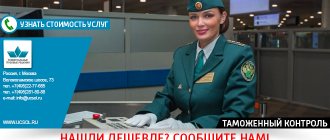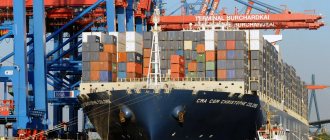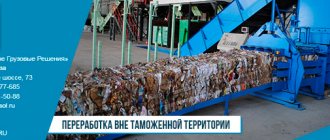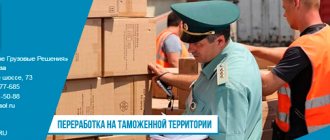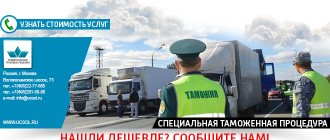27.07.2016
You may be interested in May 21, 2021 Training seminar “Documentary tools for banking support of international trade”
The country's economy and the competitiveness of our organizations in foreign markets are directly affected by the established types of customs procedures. Therefore, it is very important to correctly understand and use the legislative norms of the CU (Customs Union) for enterprises engaged in foreign trade activities, as well as for the customs authorities themselves.
How not to get confused? Customs procedure: types and classification
Depending on the structure of the customs process
There are different types of customs procedures:
· independent elements forming it (special customs procedures);
· being in the process of customs clearance (temporary storage, customs transit).
Types of customs procedures in accordance with the purposes of movement of goods
and transport across the customs border:
· carried out by enterprises and individual entrepreneurs for the purposes of commercial movement (special customs procedures for vehicles);
· carried out by individuals (temporary import, temporary export of goods and vehicles for personal needs), including special customs procedures for the movement of goods by certain categories of citizens of other states.
Depending on the items moved across the customs border
for commercial purposes, the following are distinguished:
· customs procedures for goods;
· types of special customs procedures for vehicles (temporary import, temporary export of vehicles), spare parts and equipment (Chapter 48 of the Customs Code).
According to the type of vehicle
which is used during movement, as well as the method of moving goods, the following types of customs procedures are distinguished:
· special customs procedures for goods that are transported by international mail, power lines and pipeline transport (Chapter 47 of the Customs Code of the Customs Union);
· general customs procedures for goods that are transported by conventional modes of transport: railway, road, air, sea and river.
Such a classifier of types of customs procedures makes it easier to understand the stages of the customs process established by law and the mutual conditionality of customs procedures, and therefore to avoid mistakes in the interpretation of the norms of the Customs Code of the Customs Union.
The Russian Customs Code of 2004 distinguished 4 groups of customs regimes in accordance with their use: basic, economic, final and special. Today there is no such classification, and customs procedures are not divided into groups.
But if previously the main provisions on customs regimes and procedures were recorded in the Customs Code and reflected in the orders of the Federal Customs Service, now for this purpose there is the Federal Law “On Customs Regulation in the Russian Federation,” which explains certain features of the use of customs procedures in Russia.
General Director speaks
The emergence of the Customs Union had a positive impact on customs procedures
Tatyana Podkorytova
, General Director of Transport, Novosibirsk.
Of course, all companies are happy about new sales markets, reducing the time for clearing goods at customs and reducing the costs of foreign trade operations. For business, our unified Labor Code contains favorable provisions:
- Now the customs declaration is reviewed within the working day following its submission (in fact, 2 days in advance). Previously it took 3 days. Thus, this innovation allows businesses to deliver goods to consumers faster.
- Goods can now be kept in a temporary storage warehouse for 4 months rather than 15 days (as before). Accordingly, until the cargo is released from the temporary storage warehouse, the company has the right not to make customs payments. Thus, businesses no longer need to urgently withdraw working capital to pay customs duties.
- Declarants can make changes in the customs declaration after the release of goods, which significantly reduces the time required for customs clearance.
- Declaration replaced mandatory certification. Manufacturers now declare their products themselves and declare their quality. Difficulties in obtaining a certificate are significantly reduced. However, certificates and declarations of conformity that were received earlier (before 02/14/2010) are also allowed to be submitted to customs authorities until their expiration date.
Introduction
Foreign economic activity and, above all, foreign trade are associated with the movement across the customs border of the Customs Union by both legal entities and individuals of goods and vehicles that are subject to customs control.
The customs procedure is one of the most important institutions of customs law, since the movement of goods and vehicles across the customs border must be carried out in strict accordance with the declared customs procedure. The movement of goods and vehicles across the customs border in accordance with customs procedures is one of the basic principles of their movement.
The relevance of this topic is that the use of customs procedures allows, by providing certain benefits, to remove unreasonable obstacles to the development of economic, cultural, and humanitarian ties with foreign countries.
The purpose of this work is to study the types, content and characteristics of customs procedures.
Based on the goal, this work involves solving the following tasks:
— study of the concept and content of customs procedures;
— identification of types of customs procedures;
— determination of the goals and features of customs procedures;
— studying the place of customs procedures in customs regulation;
— assessment of legal regulation and practice of applying customs procedures;
— analysis of problems in the application of customs procedures.
The object of the study is the customs procedure.
The subject of research in the work is the basics of applying the customs procedure.
In this work, the following works were used in the field of studying the basics of the application of customs procedures: Bakaeva O.Yu., Barbysheva G.I., Mirzaeva Sh.F., Demina A.V., Kolesnikova P.Yu., Malinovskaya V.M. , Matvienko G.V., Nazarenko A.M., Savchenko M.S., Panina I.V., Rukavishnikova I.V., Surkichina G.F. and etc.
When conducting research on this topic, methods of analysis and synthesis, logical, comparative, system-structural, were used.
The work used federal laws, regulations of the Russian Federation regulating customs procedures, materials of scientific conferences and seminars on the topics studied, materials of periodicals, data from published reports of the Federal Customs Service.
The most commonly used customs procedures: types and characteristics
Release for domestic consumption (IM 40)
Foreign goods placed under this customs procedure can be placed and used on the territory of the Customs Union without restrictions. To do this, you need to pay customs duties and adhere to all legal restrictions and prohibitions (Article 209 of the Labor Code of the Customs Union).
Temporary import (admission) (IM 53)
Foreign goods can be used in a specific period on the Customs Union Customs Union, partially or completely conditionally exempt from payment of import customs duties and taxes. At the same time, non-tariff regulation measures with further placement under this type of customs procedures such as re-export (according to Article 277 of the Labor Code of the Customs Union) are not applicable to them.
· Full conditional release:
in paragraph 1 of Art. 282 of the Customs Code of the Customs Union states that the names of goods with the conditions and periods of such exemption are fixed on the basis of international agreements of the members of the Customs Union, and are also regulated by the decision of the Customs Union dated June 18, 2010 No. 331.
· Partial conditional release:
in paragraph 3 of Art. 282 of the Customs Code of the Customs Union states that for all full and incomplete calendar months when the goods were on the Customs Code of the Customs Union, 3% of the amount of import customs duties and taxes is collected.
Export (EC 10)
A type of customs procedures in which goods of the Customs Union are moved outside the Customs Union Customs Union for permanent residence there.
According to Art. 213 of the Customs Code of the Customs Union, these goods can undergo this customs procedure only if export customs duties are paid
(when there are no benefits for paying such duties).
· The declarant’s need to pay export customs duties appears at the moment of registration of his customs declaration by the customs authorities, and ends in certain clause 2 of Art. 80 TC TC cases.
· Payment of such duties must be made before the release of goods according to the customs export procedure, when other periods are not determined by law (Article 214 of the Labor Code of the Customs Union).
Customs transit (IM 80, EK 80)
One of the conditions for placing goods under this customs procedure is the adoption of measures to implement customs transit (Article 216 of the Customs Code of the Customs Union). Such measures include payment of customs taxes and duties (Article 217 of the Labor Code of the Customs Union).
The obligation to pay import customs duties and taxes in relation to foreign goods placed under this type of customs procedures arises for the declarant after registration of his declaration by the customs authorities (under Article 227 of the Customs Code of the Customs Union).
Processing in customs territory (IM 52)
A type of customs procedures in which foreign goods are processed at the Customs Union Customs Union within a certain period of time with full conditional exemption from payment of import customs duties and taxes and without the use of non-tariff regulation measures with the further export of processed products outside the Customs Union Customs Union.
The obligation to pay import customs duties and taxes in relation to foreign goods placed under this type of customs procedures arises for the declarant after registration of his declaration by the customs authorities (according to paragraph 1 of Article 250 of the Customs Code of the Customs Union).
Processing for domestic consumption (IM 91)
According to this customs procedure, foreign goods are processed at the Customs Union Customs Union within a certain time frame without paying import customs duties, but with the implementation of prohibitions and restrictions, including the implementation of special protective, anti-dumping and compensation measures, with the further placement of processed products under the release procedure for domestic consumption and payment of import customs duties at rates fixed for processed products.
When placing goods under this type of customs procedures, customs duties and VAT are paid (Article 151 of the Tax Code of the Russian Federation).
The obligation to pay import customs duties and taxes in relation to foreign goods placed under this type of customs procedures arises for the declarant after registration of his declaration by the customs authorities (clause 1 of Article 274 of the Customs Code of the Customs Union).
Processing outside the customs territory (EC 21)
Under this procedure, CU goods are exported from the CU TT during the designated period, completely conditionally exempt from payment of export customs duties, while non-tariff regulation measures are not applied to them with the further import of processed products into the CU TT. The obligation to pay export customs duties and taxes in relation to goods placed under this type of customs procedures arises for the declarant after registration of his declaration by the customs authorities (clause 1 of Article 261 of the Customs Code of the Customs Union).
Customs warehouse (IM 71, 72)
A type of customs procedures in which foreign goods can be stored in a customs warehouse for a designated period without paying customs duties and taxes, and non-tariff regulation measures are not applied to them.
The obligation to pay import customs duties and taxes in relation to foreign goods placed under this type of customs procedures appears (according to paragraph 1 of Article 237 of the Customs Code of the Customs Union):
· for the declarant - after registration of his declaration by the customs authorities;
· from the owner of a customs warehouse - after placing goods in this warehouse.
Temporary removal (ek 23)
CU goods are exported for use outside the borders of the CU during the designated period with full exemption from payment of export customs duties; non-tariff regulation measures are not applied to them with further placement under the re-import procedure. The obligation to pay export customs duties and taxes in respect of goods placed under this type of customs procedures arises for the declarant after registration of his declaration by the customs authorities (under Article 290 of the Customs Code of the Customs Union).
Re-import (they are 61, 63)
With such a customs procedure, goods that were previously exported from the Customs Union Customs Union are again imported to the Customs Union Customs Union within the period specified in Art. 293 Labor Code of the Customs Union (3 years) without payment of import customs duties, taxes and the application of non-tariff regulation measures to them.
Art. 295 of the Customs Code of the Customs Union states that for goods that were placed under such types of customs procedures as export or processing in the Customs Union, upon re-import, a refund (or offset) of the paid amount of export customs duties is made, provided that these goods are not under the re-import procedure later than 6 months from the date following the day they were placed under the export procedure.
Re-export (EC 31)
Under this procedure, goods that were previously imported into the TT CU, or that are under the processing procedure at the TT, are exported from there without payment (with a refund) of the amount of import customs duties, taxes and without the use of non-tariff regulation measures.
According to Art. 301 of the Customs Code of the Customs Union, if goods that are under the customs procedure of release for domestic consumption are returned due to the failure of a foreign economic transaction (period - 1 year, identification and other conditions), then during the procedure of re-export and actual export from the Customs Union of the Customs Union it is necessary to return (offset ) paid amount of import customs duties and taxes (Chapter 13 of the Labor Code of the Customs Union).
Duty free trade (IM 96)
A type of customs procedures in which goods are sold at retail in special duty-free shops: to persons leaving the Customs Union, diplomatic foreign missions and identical representative offices of international organizations, consulates, diplomatic agents and consular officials, members of their families living with him ( without paying customs duties, taxes and applying non-tariff regulation measures).
Only the owner of the duty-free store where these goods are sold has the right to act as a declarant for goods placed under the customs procedure of duty-free trade.
The obligation to pay import customs duties and taxes in relation to foreign goods placed under this type of customs procedures appears with the declarant after registration of his declaration by the customs authorities (clause 1 of Article 306 of the Customs Code of the Customs Union), and ends after the sale of these goods or their placement under other customs procedure.
- Customs transit: simplified passage scheme from ICC
How goods are placed under types of customs procedures
It should be understood that the placement of goods under the customs procedure occurs at the moment when a customs declaration
and/or other necessary documentation.
Customs declaration of goods is carried out by the declarant or a customs representative acting on his behalf.
The result of placement under the customs procedure is the release of goods
according to the declared customs procedure.
Any operations at customs to place goods under customs procedures must be carried out only during business hours. Customs authorities are located at checkpoints across the customs border, but in addition to them, there are also internal customs authorities.
It is worth noting that certain customs operations may not be carried out during business hours, and also not at the locations of customs authorities. Such cases are possible only at the request (written!) of the declarant or his customs representative, unless this reduces the effectiveness of customs control over the movement of goods and vehicles across the border.
When submitting a customs declaration
in writing, the customs authorities also need to provide an electronic copy of it, unless otherwise determined by the Customs Code of the Customs Union, the decision of the Customs Union Commission and the legislation of the Customs Union members.
For example, an electronic copy is not needed for passenger customs declarations, as well as for vehicles.
Filing a customs declaration
occurs in conjunction with the provision of documentation on the basis of which it was filled out. If such documentation does not contain the information specified in the customs declaration, then it must be replaced with documents that reflect this information.
In cases where some of the documents on the basis of which the customs declaration was filled out cannot be provided together with the customs declaration, after the declarant has justified the reasons, the customs authorities may allow them to be provided both before and after the release of goods.
When documents used for customs declaration have already been submitted to the customs authority, submitting copies is quite sufficient
such documents or information about it. A customs declaration on goods imported into the territory of the Customs Union must be submitted before the end of their temporary storage period, that is, 4 months. A customs declaration for goods exported from the Customs Union should be submitted before their export from the Customs Union, unless otherwise stated in the Customs Code of the Customs Union.
The customs declaration is submitted by the declarant (
customs representative) only to those customs authorities that are granted the right (by the legislation of the CU member countries) to carry out their registration.
The customs authority registers
customs declaration or refuses no later than 2 hours after receiving the customs declaration, as determined by decision of the CU Commission No. 262 of May 20, 2010.
ok. One of the conditions for placing goods under types of customs procedures is the payment of customs duties
(unless otherwise provided for in the Customs Code).
Payment deadlines
customs duties and taxes are fixed as part of the regulation of each type of customs procedures. Typically, these deadlines are set before the goods are released.
Payers of customs duties and taxes are declarants or other entities who are assigned this obligation by the Customs Code, international agreements or laws of the Customs Union members (Article 79 of the Customs Code).
According to Art. 196 of the Customs Code of the Customs Union, customs authorities must release goods no later than one working day after the date of registration of the customs declaration
, when otherwise is not indicated in the Customs Code of the Customs Union.
And for goods to which export customs duties are not applied, which are placed under such types of customs procedures as export and temporary export, and the list of which is compiled by the Customs Union Commission, the release period is 4 hours after registration of the declaration.
What modes can be changed
Goods are placed under the selected procedure from the moment the declaration and other documents are submitted to the customs officer. As a result, the cargo is passed according to the conditions of the selected regulations.
If changes are necessary, the decision on the possibility of applying the new procedure is made by the customs authority. Most often, such a procedure is required if the person responsible for the movement changes his intentions regarding the use of the cargo or the validity period of the previously selected mode expires.
- When importing goods for sale, certificates and payment of duties are required. If there is a delay in processing documents or the declarant has financial problems, the products are first placed in a customs warehouse. The regime changes to “free circulation” after all documents have been completed.
- When importing products to exhibitions, a temporary import regime is applied. If someone buys a product, the transition to “free circulation” takes place. The same procedure applies to expensive products (exclusive clothing, jewelry) imported for sale. Temporary import is replaced only after purchase. The re-registration is carried out by the buyer simultaneously with the signing of the purchase and sale agreement.
There are situations in which the mode cannot be changed:
- the product does not comply with the selected regulations;
- products were confiscated in favor of the state.
All cases are very individual and depend on many factors. Basic information does not guarantee a solution to your specific problems. That's why FREE expert consultants work for you around the clock! right now through the form (below), and our lawyer will call you back within 5 minutes with a free consultation.
